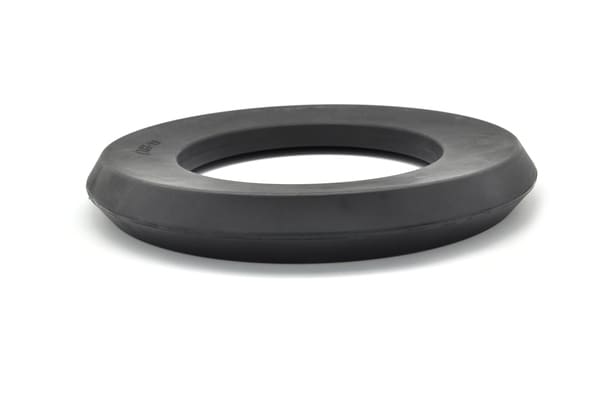Choosing the right washer can make all the difference in your projects. But how do silicone washers compare to rubber washers? Let's dive into their differences and find out which is better for your needs.
Silicone washers and rubber washers are both essential in sealing and vibration dampening applications. The choice between them depends on specific needs such as temperature resistance, durability, and material properties.

To make an informed decision, it's essential to understand what rubber washers1 are, the types available, and when to use them. Let’s explore these key points before comparing silicone washers2 to rubber washers.
What Are Rubber Washers?
Rubber washers are versatile components, commonly used in various applications to seal, cushion, and distribute pressure. But what exactly are they, and how do they work?
A rubber washer is a flat, ring-shaped component designed to create a seal between two surfaces. Made from flexible rubber materials, they are used to prevent leaks and reduce friction in mechanical systems.
Rubber washers are typically used in mechanical assemblies where a tight seal or vibration dampening is required. The flexibility of rubber allows the washer to conform to uneven surfaces, creating a tight seal and preventing fluid or air leakage. Rubber washers are also used to distribute pressure evenly, preventing damage to sensitive components.
They are commonly used in industries like plumbing, automotive, construction, and HVAC, as well as electrical applications where insulation is necessary. The material used for rubber washers varies, with options including nitrile, EPDM, neoprene, and silicone, each offering different properties like oil resistance, UV resistance, and weatherability.
Rubber washers are affordable, durable, and reliable. They are widely available in various sizes and thicknesses to meet the demands of different industries.
Types of Rubber Washers
- Nitrile (NBR): Oil and fuel-resistant, often used in automotive and industrial applications.
- EPDM: Excellent for weather and ozone resistance, ideal for outdoor applications.
- Neoprene: Good resistance to oils and weathering, used in HVAC and plumbing.
- Silicone: High-temperature and chemical resistance, often used in food-grade and medical applications.
The choice of material for a rubber washer depends largely on the specific needs of the application. Here’s a breakdown of some of the most common rubber washer materials and their uses:
| Material | Key Properties | Common Uses |
|---|---|---|
| Nitrile | Resistant to oils and fuels | Automotive, industrial, fuel systems |
| EPDM | Resistant to UV, ozone, and weathering | Outdoor applications, electrical, HVAC |
| Neoprene | Resistant to oils, weather, and aging | Plumbing, HVAC systems, refrigeration |
| Silicone | High-temperature resistance, flexible, non-toxic | Food and medical applications, high-temperature systems |
Each material offers specific benefits. For instance, Nitrile washers are ideal for fuel systems, while EPDM is preferred for outdoor use due to its weather resistance. Silicone washers are commonly used in food-grade applications because they are non-toxic and safe for contact with consumables.
When to Use Rubber Washers?
Knowing when to use rubber washers is key to ensuring the reliability of your project. Let’s explore the scenarios where rubber washers are essential.
Rubber washers are primarily used for sealing, vibration dampening, and distributing pressure. They're ideal for situations where you need to prevent leakage, reduce friction, or absorb shock.
Rubber washers are used across multiple industries, and their applications vary depending on the specific needs of the system. Here are the key scenarios where rubber washers are commonly employed:
- Sealing: Rubber washers are widely used in plumbing systems to seal connections, preventing water leaks. They are also used in automotive systems to seal parts of the engine, preventing oil and fuel leaks.
- Vibration Dampening: In industrial machinery, rubber washers are used to absorb vibrations, reducing wear and tear on sensitive parts.
- Pressure Distribution: In applications like HVAC systems, rubber washers are used to evenly distribute pressure between components, ensuring a secure and stable connection.
The material properties of rubber washers make them suitable for a wide range of environments, from high temperatures to harsh chemicals, ensuring that they remain effective in demanding conditions.
Silicone Washers vs Rubber Washers
Now, let’s take a deeper look at the differences between silicone washers and rubber washers. Which one is better for your application?
Silicone washers are known for their high-temperature resistance and flexibility, making them ideal for food-grade and medical applications. Rubber washers, on the other hand, are more versatile in terms of material types, offering options for oil resistance, UV resistance, and more.
The main difference between silicone washers and rubber washers lies in their material properties and the specific applications they are designed for. Silicone washers offer superior high-temperature resistance3, which is why they are commonly used in food-grade and medical applications where safety and non-toxicity are crucial. Silicone’s flexibility also makes it a good choice for sealing and vibration dampening in systems subject to extreme temperatures.
Rubber washers, on the other hand, are available in various materials such as Nitrile, EPDM, and Neoprene, each suited for different environments. For example, Nitrile washers are ideal for oil and fuel systems, while EPDM washers excel in outdoor applications due to their UV and ozone resistance.
While silicone washers are ideal for high-temperature and food-grade applications, rubber washers offer more variety and are generally more cost-effective. In terms of flexibility and durability, both materials can perform exceptionally well, but the choice depends on your specific needs.
Key Differences Between Silicone and Rubber Washers
| Feature | Silicone Washers | Rubber Washers |
|---|---|---|
| Temperature Resistance | High-temperature resistance, up to 300°C | Moderate, varies by material |
| Chemical Resistance | Good for high-chemical environments | Varies by material (e.g., Nitrile for oils) |
| Flexibility | Highly flexible and durable | Varies, but generally less flexible than silicone |
| Cost | Generally more expensive | More affordable, available in many materials |
| Common Uses | Food-grade, medical, high-temp applications | Automotive, industrial, plumbing, HVAC |
Conclusion
Silicone washers and rubber washers each have their strengths, with silicone excelling in high-temperature and food-safe applications, while rubber washers offer versatility and cost-effectiveness for various industrial needs.
Learn about the various types of rubber washers and their specific applications to choose the right one for your needs effectively. ↩
Explore the unique advantages of silicone washers, especially in high-temperature and food-safe applications, to make informed choices for your projects. ↩
Understanding temperature resistance is crucial for selecting the right washer for your application, ensuring reliability and performance. ↩







